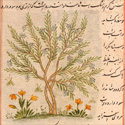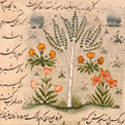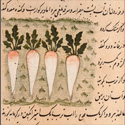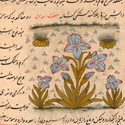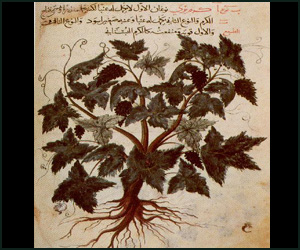Farming

|
On the Muslim role in agricultural
development, Cherbonneau holds:
`it
is admitted with difficulty that a nation in majority of nomads
could have had known any form of agricultural techniques other
than sowing wheat and barley. The misconceptions come from the
rarity of works on the subject… If we took the bother to open up
and consult the old manuscripts, so many views will be changed,
so many prejudices will be destroyed.’[1]
So
many prejudices, which can be easily found with many authors
such as Ashtor who says:
`The
numerous accounts of these activities do not point to
technological innovations within the irrigation system, which
the Muslim rulers had simply taken over from their predecessors.
The records in the writings of the Arabic historians show that
those who drained the swamps and dug the canals were the
Nabateans, not Arabs
.’
[2]
`The information which
the Arabic authors provide us in the methods of agricultural
work, besides the irrigation canals and engines, is rather
scanty. But collecting these records from various sources one is
inclined to conclude that the Arabs
did not improve the
methods of agricultural work. There is only slight evidence of
technological innovations in near eastern agriculture throughout
the Middle Ages, whereas the history of European agriculture is
the story of great changes and technological achievements.’[3]
This picture of
inept Muslim farmers, shared by the overwhelming majority of
historians is contradicted by historical evidence. In fact, an
Islamic agricultural revolution preceded its European
counterpart by at least six centuries, Muslims pioneering in
many areas that were later on to be identified with the European
agricultural revolution.[4]It
was also from Islam that many such pioneering elements were to
transfer to Western Christendom
as will be amply shown
in this section.
Before looking at such
impacts, it is worth making a brief outline of Islamic early
accomplishments in farming. Artz tells us that the great Islamic
cities of the Near East, North Africa, and Spain were all
supported by an elaborate agricultural system that included
extensive irrigation and an expert knowledge of agricultural
methods, which were the most advanced in the world.[5]
The Muslims knew how to fight insect pests, how to use
fertilizers, and they were experts at grafting trees and
crossing plants to produce new varieties, and by these means
areas that have since become lands of low agricultural
production were able, in early Islam to support huge
populations.[6]
Cereal yields in Egypt
according to Von Sivers
were around 10 for 1, yields, which will only be obtained in
Europe at the end of the 17th century.[7]
In Muslim Spain, such was the quality of product some wheat
could keep for a century in adequate storage conditions.[8]
In Sicily
,
agriculture remained in Muslim hands
under Norman rule, and was, according to Scott `carried
to the highest perfection.’[9]
There, every plant or tree, whose culture was known to be
profitable and which could adapt itself was to be found in the
gardens and plantations; records were kept of the crops produced
in each district; the methods of their disposition and the
prices they brought were noted on the public registers; the
breeds of horses, asses, and cattle were improved; and the
greatest care was taken of them; and food, which after
experiment was found to be the most nutritious, was adopted.[10]
Bolens, thus, concludes that Islamic
farming represented: `a culmination of a unique balance derived
from a deep love for nature… a relaxed way of life, ecological
balance, and the acquisition of knowledge of many `civilized
traditions.'[11]
Gardens
and gardening, for
pleasure, experimentation, or as subsidiary economic outlet,
used to form an integral part of Islamic life.
In Algiers, a visitor once
counted 20,000 gardens, and all around the city grew all sorts
of fruit trees; great varieties of flowers, and all sorts of
plants; fountains abounded, and in these gardens, on the lush
greenery, families used to come and find enjoyment and solace.[12]
In Spain, writers speak endlessly of the gardens and lieux de
plaisance of Seville
, Cordova and Valencia
, the last of which was called by one of them ``the scent bottle
of al-Andalus.’[13]
Market gardens, olive groves, and fruit orchards made some areas
of Spain—notably around Cordova, Granada, and Valencia—"garden
spots of the world." The Island of Majorca, won by the Muslims
in the 8th century, became under their husbandry `a
paradise of fruits and flowers, dominated by the date palm that
later gave its name to the capital.’[14]
The picture
that emerges, according to Watson
, is
that of `a large unified region which for three or four
centuries, and in places still longer, was unusually receptive
to all that was new,’[15]
and also was `unusually able to diffuse novelties;’ and more
crucially: `both to effect the initial transfer which introduced
an element into a region and to carry out the secondary
diffusion which changed rarities into commonplaces.’[16]To
accomplish this, attitudes, social structures, institutions, the
economy, infrastructure, science all played their part; and not
only in farming, but also in other spheres of the economy, and
outside the economy; all `touched by this capacity to absorb and
to transmit.’[17]
How Islamic civilisation diffused all such green science to the Christian West is what focus is on here
[1]
A. Cherbonneau:
Kitab al-Filaha of Abu Khayr al-Ichbili, in
Bulletin d’Etudes
Arabes, pp 130-44; at p. 130.
[2]
E. Ashtor: A Social; op cit; p. 46.
[3]
Ibid. p. 49.
[4]For
accounts on the Muslim agricultural revolution, see for
instance:
-A.M. Watson
: Agricultural Innovation in the Early Islamic World;
Cambridge University Press; 1983.
-A.M. Watson
: `The Arab Agricultural revolution and its diffusion,'
The Journal of Economic History 34 (1974): pp. 8-35.
-T. Fahd: Botany
and Agriculture
, in the Encyclopaedia (Rashed ed) pp 813-52.
[5]
F.B. Artz: The Mind;
op cit; pp. 149-50.
[6]
Ibid.
[7]
In P.Guichard: Mise en valeur du sol et production: De
la `revolution agricole’aux difficultes du bas Moyen
Age; In
Etats et Societes (J.C. Garcin et al edition); Vol
2; Presses Universitaires de France; p.2000; pp. 175-99;
at p. 184.
[8]
E. Levi Provencal: Histoire de l'Espagne Musulmane;
Vol III; Paris, Maisonneuve, 1953. p. 272.
[9]
S.P. Scott: History; op cit;
vol 3; p. 42.
[10]
Ibid.
[11]
L. Bolens: `Agriculture
’ in Encyclopaedia (H Selin ed); op cit;
pp 20-2, p. 22.
[12]
In G.Marcais: Les Jardins de l’Islam; in Melanges
d’Histoire et d’Archeologie de l’Occident Musulman;
2 Vols; Alger; 1957; pp 233-44; p. 241.
[13]
H. Peres: La Poesie Andaluse en Arabe Classique au
Xiem siecle; Paris; 1953; pp. 115ff.
[14]
W. Durant: The Age of faith; op cit; p. 298.
[15]
A. Watson
: Agricultural innovation, op cit, p.2
[16]
Ibid.
[17]
Ibid.
|

